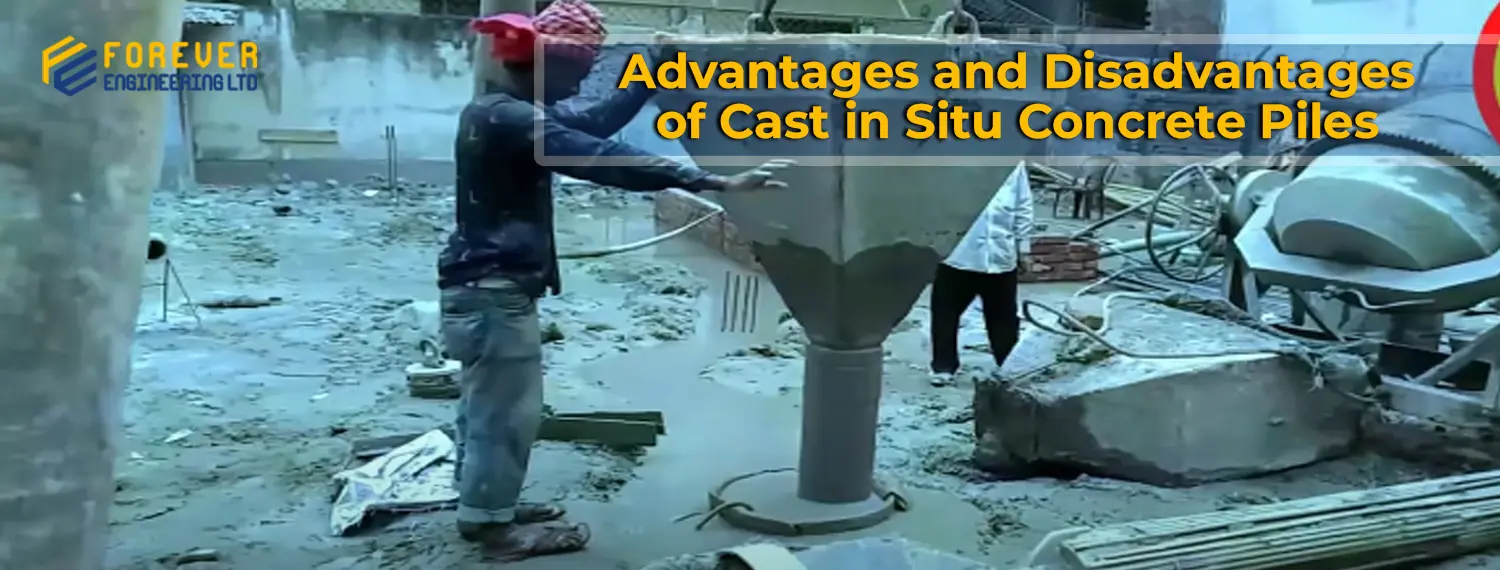When building a concrete shape, contractors have to pick a technique. Cast in situ piles are one of the most commonplace and oldest strategies of concrete creation, and Forever Engineering is one of the most famous piling creation organizations Today’s developers can nonetheless obtain the benefits of this approach and they try to triumph over its shortcomings. With this in mind, today we’re going to consciousness the Advantages and Disadvantages of Cast in Situ Concrete Piles. So allow’s get commenced.
What are Cast in Situ Concrete Piles?
Table of Contents
ToggleCast-in-situ concrete, additionally referred to as solid-in-area concrete, is a constructing production technology that includes casting partitions and slabs on-website in formwork. This differs from the precast concrete era, in which slabs are cast somewhere else after which transported to the construction website online and assembled. Its partitions are made of concrete slabs rather than bricks or timber panels, and formwork is used for both walls and roofs.

Cast-in-area concrete, a product and corporation founded via Thomas Edison, became in particular applied for under-grade basement partitions after the patent of Portland cement.
Even though he built entire houses out of concrete, Edison diagnosed the advantages of the use of solid-in-vicinity concrete for above-grade packages. Some of those strong, moderately priced homes still stand nowadays, but society deemed them too unsightly.
Although this assignment became unsuccessful, the idea of increasing using forged-in-region concrete turned into no longer.
Uses of Driven Cast in Situ Piles
The Following Conditions Make the Construction Company Use the Piles
- Situ piles are used when the soil at the construction site is extremely loose or soft.
- When the plan area is not sufficient because the loads are too high, the required size of the foundation can’t be accommodated.
- When the foundation is under a lot of lateral load, these piles are utilized.
- The pile foundation is used to build underground structures and transmission towers below the water table that must withstand massive uplift loads.
- This pile foundation is used when the foundation must support moments, eccentric loads, and inclined loads.
Cast in Situ Pile Construction Method
- The cast-in-situ pile construction method involves creating piles on the construction site.
- First, a hole must be drilled into the ground using specialized tools, such as a rotary drill.Advantages and Disadvantages of Cast in Situ Concrete Piles
Cast in situ concrete piles gained popularity. The numerous benefits this building method provided to construction projects were too great to pass up. On the other hand, this cast in situ pile has disadvantages too. Let’s learn cast in situ piles advantages.
Advantages and Disadvantages of Cast in Situ Concrete Piles
Advantages of Cast in Situ Concrete Piles
Strength
The outcome significantly boosts the building’s strength since it creates a single monolithic structural system. Cast-in-situ concrete structures can endure extreme weather conditions and higher loads due to their initial exposure to them.
With the addition of steel reinforcement, this technique yields a structure with high compressive strength as well as tensile strength.
These two characteristics work together to give these structures extraordinary resistance to shear and seismic forces.
Cost-Effectiveness
Driven cast in situ piles allow forms to be repeatedly reused. It results in significant financial savings. No additional investment is required in this area because only basic concrete products and no specialized equipment are required.
Insulation
Both interior and exterior cast-in-situ concrete walls provide insulation. The exterior walls provide thermal insulation against harsh weather. Internal walls provide sound control, ensuring that activities in each room remain isolated.
This insulation also protects against mold, mildew, and insects, which can harm the structure and its inhabitants.
Versatility
Cast-in-place concrete forms can be customized to create concrete panels of any shape. This allows the builder to design a unique and eye-catching structure. This method can form complex, curved, or irregular shapes.
Smoother Finish
Cast-in-place concrete does not have noticeable, unsightly gaps or cracks because it is formed into a single, monolithic structure.
In Summary:
- Piles of any size or length may be used for construction at the site.
- Damage caused because of driving or handling in the case of precast piles is eliminated.
- The Situ Piles are the best-suited piles for Heavy Equipment Companies. They are used in places where any type of vibration needs to be avoided. This helps preserve the safety of the adjoining structure.
- Soils with poor drainage qualities should be inserted with the Situ piles because these piles do not impact the surrounding soil.
Disadvantages of Cast in Situ Concrete Piles
While this method of building with concrete offers many advantages, it does have a couple of drawbacks.
Labor Intensive
For poured-in-place concrete, more worker hours and wages are needed for the assembly and disassembly of the formwork than for other techniques. The addition of reinforcement bars raises labor costs further.
This means that building a structure that satisfies the requirements falls under the purview of competent personnel who can accomplish these tasks and adhere to the proper protocols.
Time Intensive
It takes time to build the forms and to wait for the concrete to solidify before removing it. Furthermore, unforeseen weather can cause delays in the building and curing processes.
This can be very annoying for large projects. A single delayed pour can throw off the entire schedule.
In Summary:
- Strict quality control and close supervision are necessary for the installation of Situ Piles, as they are for all types of building materials.
- The construction process may involve a complex method due to the need for adequate storage space for all types of materials.
- Because of the soil’s compaction, known as granular soil, more bearing equipment hiring capacity is required. This is created using a driven pile rather than a situ pile.
- Situ Piles cannot be used for construction in areas where there is high artesian pressure or groundwater current.
- Following the drilling process, the hole is filled with reinforcing steel bars, or rebar, which offer structural support.
- After that, concrete is poured into the hole to form the pile and encircle the rebar.
- The concrete is allowed to cure and harden, resulting in a solid foundation for structures.
- This method is appropriate for a variety of soil conditions and can be applied to small—and large-scale construction projects.
- It allows for flexibility in pile design and can accommodate varying load requirements.
- Quality control is essential during the construction process to ensure the integrity and stability of the piles.
Why Forever Engineering for Cast in Situ Piles?
Forever Engineering LTD has extensive experience with driven cast-in-situ piles. We evolve the technique to ensure that high-quality standards are achieved at all times. Our team of experts is knowledgeable about the latest technologies of cast-in-situ concrete piles and ensures that each pile meets the required standards and specifications.
Clients can rely on us to complete projects in a timely manner, with a focus on safety, quality, and client satisfaction. Get in touch with us if you need any guidance.
Final Words
Finally, you have learned about the Advantages and Disadvantages of Cast in Situ Concrete Piles. For the building industry, cast-in-place concrete has several advantages.
Should you need driven cast in situ piles construction for your upcoming project? Get in touch with Forever Engineering to have your next commercial concrete structure.

